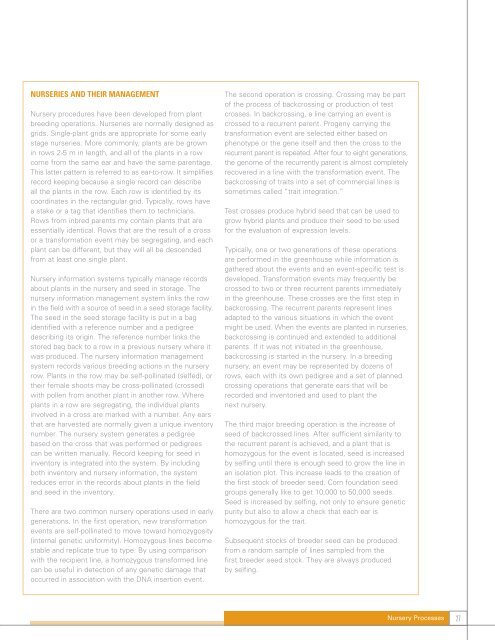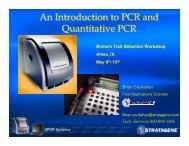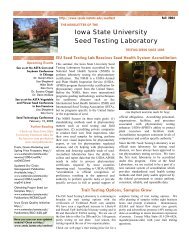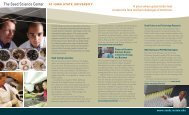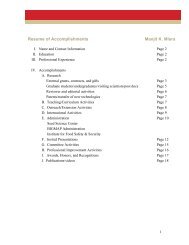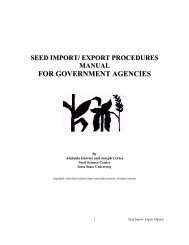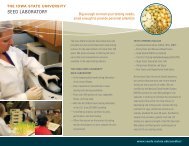Confined Production Processes for Non-Food Corn - Seed Science ...
Confined Production Processes for Non-Food Corn - Seed Science ...
Confined Production Processes for Non-Food Corn - Seed Science ...
You also want an ePaper? Increase the reach of your titles
YUMPU automatically turns print PDFs into web optimized ePapers that Google loves.
NURSERIES AND THEIR MANAGEMENTNursery procedures have been developed from plantbreeding operations. Nurseries are normally designed asgrids. Single-plant grids are appropriate <strong>for</strong> some earlystage nurseries. More commonly, plants are be grownin rows 2-5 m in length, and all of the plants in a rowcome from the same ear and have the same parentage.This latter pattern is referred to as ear-to-row. It simplifiesrecord keeping because a single record can describeall the plants in the row. Each row is identified by itscoordinates in the rectangular grid. Typically, rows havea stake or a tag that identifies them to technicians.Rows from inbred parents my contain plants that areessentially identical. Rows that are the result of a crossor a trans<strong>for</strong>mation event may be segregating, and eachplant can be different, but they will all be descendedfrom at least one single plant.Nursery in<strong>for</strong>mation systems typically manage recordsabout plants in the nursery and seed in storage. Thenursery in<strong>for</strong>mation management system links the rowin the field with a source of seed in a seed storage facility.The seed in the seed storage facility is put in a bagidentified with a reference number and a pedigreedescribing its origin. The reference number links thestored bag back to a row in a previous nursery where itwas produced. The nursery in<strong>for</strong>mation managementsystem records various breeding actions in the nurseryrow. Plants in the row may be self-pollinated (selfed), ortheir female shoots may be cross-pollinated (crossed)with pollen from another plant in another row. Whereplants in a row are segregating, the individual plantsinvolved in a cross are marked with a number. Any earsthat are harvested are normally given a unique inventorynumber. The nursery system generates a pedigreebased on the cross that was per<strong>for</strong>med or pedigreescan be written manually. Record keeping <strong>for</strong> seed ininventory is integrated into the system. By includingboth inventory and nursery in<strong>for</strong>mation, the systemreduces error in the records about plants in the fieldand seed in the inventory.There are two common nursery operations used in earlygenerations. In the first operation, new trans<strong>for</strong>mationevents are self-pollinated to move toward homozygosity(internal genetic uni<strong>for</strong>mity). Homozygous lines becomestable and replicate true to type. By using comparisonwith the recipient line, a homozygous trans<strong>for</strong>med linecan be useful in detection of any genetic damage thatoccurred in association with the DNA insertion event.The second operation is crossing. Crossing may be partof the process of backcrossing or production of testcrosses. In backcrossing, a line carrying an event iscrossed to a recurrent parent. Progeny carrying thetrans<strong>for</strong>mation event are selected either based onphenotype or the gene itself and then the cross to therecurrent parent is repeated. After four to eight generations,the genome of the recurrently parent is almost completelyrecovered in a line with the trans<strong>for</strong>mation event. Thebackcrossing of traits into a set of commercial lines issometimes called “trait integration.”Test crosses produce hybrid seed that can be used togrow hybrid plants and produce their seed to be used<strong>for</strong> the evaluation of expression levels.Typically, one or two generations of these operationsare per<strong>for</strong>med in the greenhouse while in<strong>for</strong>mation isgathered about the events and an event-specific test isdeveloped. Trans<strong>for</strong>mation events may frequently becrossed to two or three recurrent parents immediatelyin the greenhouse. These crosses are the first step inbackcrossing. The recurrent parents represent linesadapted to the various situations in which the eventmight be used. When the events are planted in nurseries,backcrossing is continued and extended to additionalparents. If it was not initiated in the greenhouse,backcrossing is started in the nursery. In a breedingnursery, an event may be represented by dozens ofrows, each with its own pedigree and a set of plannedcrossing operations that generate ears that will berecorded and inventoried and used to plant thenext nursery.The third major breeding operation is the increase ofseed of backcrossed lines. After sufficient similarity tothe recurrent parent is achieved, and a plant that ishomozygous <strong>for</strong> the event is located, seed is increasedby selfing until there is enough seed to grow the line inan isolation plot. This increase leads to the creation ofthe first stock of breeder seed. <strong>Corn</strong> foundation seedgroups generally like to get 10,000 to 50,000 seeds.<strong>Seed</strong> is increased by selfing, not only to ensure geneticpurity but also to allow a check that each ear ishomozygous <strong>for</strong> the trait.Subsequent stocks of breeder seed can be producedfrom a random sample of lines sampled from thefirst breeder seed stock. They are always producedby selfing.Nursery <strong>Processes</strong> 27


